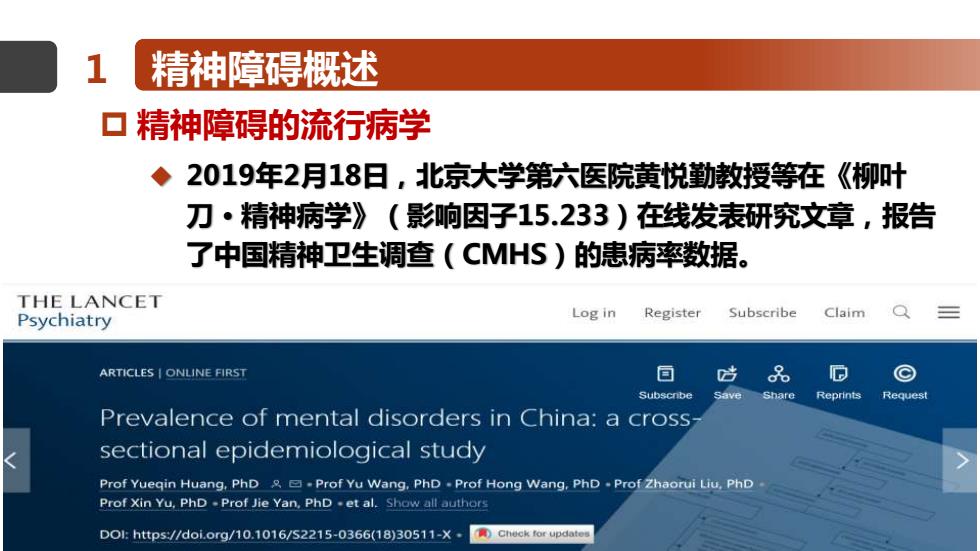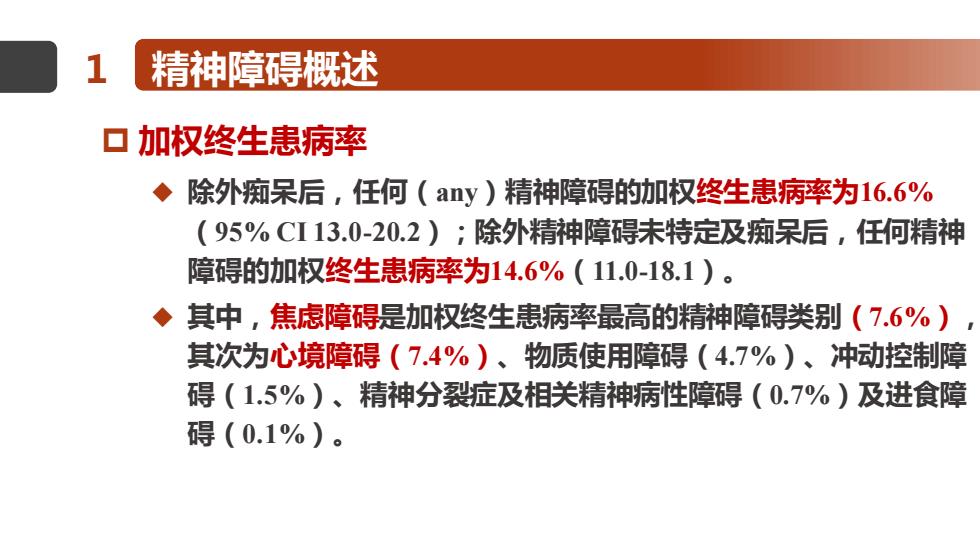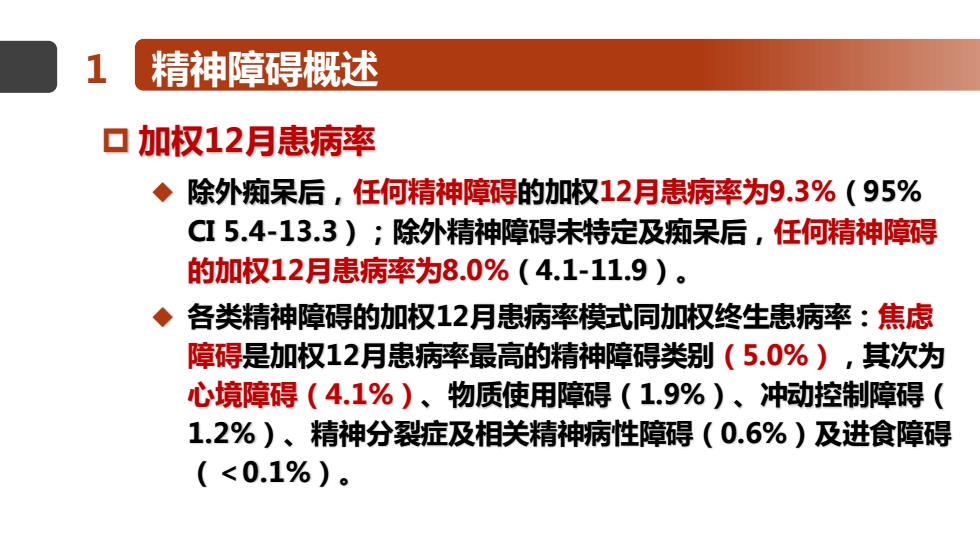
精神障碍概述 口精神障碍的流行病学 ◆ 2019年2月18日,北京大学第六医院黄悦勤教授等在《柳叶 刀·精神病学》(影响因子15.233)在线发表研究文章,报告 了中国精神卫生调查(CMHS)的患病率数据。 THE LANCET Psychiatry Log in Register Subscribe Claim Q 三 ARTICLES ONLINE FIRST 同 © Subscnbe Save Share Reprints Request Prevalence of mental disorders in China:a cross- sectional epidemiological study Prof Yueqin Huang,PhD.Prof Yu Wang,PhD.Prof Hong Wang,PhD.Prof Zhaorui Liu,PhD Prof Xin Yu,PhD .Prof Jie Yan,PhD.et al.Show all authors DOI:https://doi.org/10.1016/S2215-0366(18)30511-X.COcroupcho
1 精神障碍概述 精神障碍的流行病学 ◆ 2019年2月18日,北京大学第六医院黄悦勤教授等在《柳叶 刀 · 精神病学》(影响因子15.233)在线发表研究文章,报告 了中国精神卫生调查(CMHS)的患病率数据

1 精神障碍概述 口加权终生患病率 ◆除外痴呆后,任何(ay)精神障碍的加权终生患病率为16.6% (95%CI13.0-20.2);除外精神障碍未特定及痴呆后,任何精神 障碍的加权终生患病率为14.6%(11.0-18.1)。 ◆其中,焦虑障碍是加权终生患病率最高的精神障碍类别(7.6%) 其次为心境障碍(7.4%)、物质使用障碍(4.7%)、冲动控制障 碍(1.5%)、精神分裂症及相关精神病性障碍(0.7%)及进食障 碍(0.1%)
1 精神障碍概述 加权终生患病率 ◆ 除外痴呆后,任何(any)精神障碍的加权终生患病率为16.6% (95% CI 13.0-20.2);除外精神障碍未特定及痴呆后,任何精神 障碍的加权终生患病率为14.6%(11.0-18.1)。 ◆ 其中,焦虑障碍是加权终生患病率最高的精神障碍类别(7.6%), 其次为心境障碍(7.4%)、物质使用障碍(4.7%)、冲动控制障 碍(1.5%)、精神分裂症及相关精神病性障碍(0.7%)及进食障 碍(0.1%)

精神障碍概述 口加权12月患病率 ◆除外痴保后,任何精神障碍的加权12月患病率为9.3%(95% C15.4-13.3);除外精神障碍未特定及痴保后,任何精神障碍 的加权12月患病率为8.0%(4.1-11.9)。 ◆ 各类精神障碍的加权12月患病率模式同加权终生患病率:焦虑 障碍是加权12月患病率最高的精神障碍类别(5.0%),其次为 心境障碍(4.1%)、物质使用障碍(1.9%)、冲动控制障碍( 1.2%)、精神分裂症及相关精神病性障碍(0.6%)及进食障碍 (<0.1%)
1 精神障碍概述 加权12月患病率 ◆ 除外痴呆后,任何精神障碍的加权12月患病率为9.3%(95% CI 5.4-13.3);除外精神障碍未特定及痴呆后,任何精神障碍 的加权12月患病率为8.0%(4.1-11.9)。 ◆ 各类精神障碍的加权12月患病率模式同加权终生患病率:焦虑 障碍是加权12月患病率最高的精神障碍类别(5.0%),其次为 心境障碍(4.1%)、物质使用障碍(1.9%)、冲动控制障碍( 1.2%)、精神分裂症及相关精神病性障碍(0.6%)及进食障碍 (<0.1%)

Lifetime prevalence 12-month prevalence F手4年e中Cy,s Unweighted weighted (9596Cl) Frogueney n Unwelghted ss weighted (95s C 《)年6C1 气51》 Mood disorders" A4y多自4nee制ee《we 身 产4477.只 产酒一清 11 40D4(43) 416《清44】 》4生e4e4e年e物f 1/ G-9n4《台0,之2) 台甚(5县7.柱) 1007 644(34-望:目) 1744道-4 Major depressive disorde 1093 39%(3741 34%(29-39 655 23%(2225 21(1824 Dy内ty4w340分 414 1与4(13-16) 146《-1-17) 312 11(1-1F2) 事0物(0-1车 Dw4Ve9时 相G5 2.04(2-7-准1 326(26-39) 3122 114(10-131) 144(1-117) ts中/4格年物内#中线 台polar disorders 1,) 05%4-06) o66c34o73 111 0-4《040) 054《0306 Bipolar disorder 106 044(0305) 03《0304 03(005 Bipolar I disorder 1 =014(00201) 01m0001) 10 014%(0001》 014(001-004) Bipolar disorder nat otherwise 32 010(0102) 01轴(0102) 20 014(00-01) 014(00-01) Substance-induced mood ≤3140001-002) <01%(00-002) ≤0-1%《0-00100a) 01%(00010023 Mood disurder due to a general 20 =014《004-610y 014(00010》 17 016(0001》 a14(00日1) g34年e6年t1#t4E3y A重等x量y重iE% 1075 61(576:5) 76(63#.) 116d 41(移44 04(42-5-) 14 05t(04D6) 4《D1 034(03D4》 0物(0204) Alat对awi性hout histe3yo 111 04%(030-5) 0-4%(0-3-050 75 口-39%(020-3》 026《02-0-3》 Specifw phobia 93 28n6(2G-39) 266《22事1月 09 之24《03》 20n4(17-2:4) Social phobia 1精台 076(0:60朝3 004056鞋) 120 044《0405 046(030.5) 622 229%.《20-24) 2420-29) 41 156(13-1,63 6413-20) wt-traumatic str=每ci4rglf卡 77 》46《门,3)写) 门3《C)之-5 35 02%(01-023 0-294(0-1-03) Cmrseeslivenei mseieets climeaesieie 科写 头性4.《3.,43:43 331》 1 024(a1-023 0-2%(010-3) due to a general 01%(0o01) 29 014(01-01) 0196(00-01) 209 10(07-12) 65 03享(02-03 0496(02-0) Substance-use disorders Ay4hnt4 ce te disonde可 11口4 39%142)》 4+7m(41-》 3日 14%(12-1-5》 1,9机,-》 AE》:4644。A年% 909 36n4(33H) 4《青t年】 通机 126(11-14) t,t1,743 303 11《10-12) 139(1015) 14 05%040) 074(0.509】 696 2-54(3-27) 习1%2-主:5) 204 n-Z/6《06-】 110C09-1+4) 口rug use disorde 117 044(o305) g44(0205) 44 )%《口1:2》 31作《口口3》 34(02-3) 40 01(002) #口4 56 0240103》 02物(01-0) -014(0001003》 -0-16(0001002》 Impulse-control disorders 391 14%(13-1) 156(1-3-1 290 10(09-11 Any eating disorde时 13 -0160:02001) 31C》-013 5 ■01m(0.002-003) 014(0-0010-.06》 Anorewia <D-16《0O1-,05 <0:1%(00010073 1 D+13CD-3T一D1》 <0-14(0-0010-004) (T4白2Ot和son nent9》
1 精神障碍概述

Lifetime prevalence 12-month prevalence Frequency,n Unweighted Weighted%(95%Cl) Frequency,n Unweighted% Weighted%(95%Cl) (95%CI) (95%CI) (Continued from previous page) Schizophrenia and other psychotic disordersts Schizophrenia or any other 40 09%(04-1.5) 0-7%(03-12) 27 07%(0.2-13) 06%(0-2-11) psychotic disorder Schizophrenia 24 05%(01-10) 0-6%(01-10) 21 05%(0.1-09) 06%(01-10) Other psychotic disorders 16 0-4%(0008) 02%(00-0-3) 6 02%(00-05) 01%(0001) Schizophreniform disorder ≤01%(0001-001) 01%(0.0010:01) <01% ≤01% Schizoaffective disorder 0 <01% <0-1% 0 <0-1% <01% Delusional disorder 3 01%(00033) <01%(0001-0.02) 01%(0003) <01%(0.001001) Brief psychotic disorder 2 01%(0001-003) 01%(00-02) 0 <01 <01% Substance-induced psychotic 2 0-1%(00-03) <0-1%(0001-0-08) 1 <0-1%(0.001-0-01) <01%(0-001-005) disorder Psychotic disorder due to a 3 01%(0-0-03) ≤0-1%(0001-008) 0.1%(00-03) <0-1%(00010-08) general medical condition Psychotic disorder not otherwise ×01%(00-004) <0-1%(0.001003) 1 <01%(0,001-0-01) ≤01%(0.001-0002) specified DementiaSl Dementia 157 59%(44-73) 56%(35-7.6) Any disorderss Any disorders (excluding 4047 157%(134-18.1) 166%(130-202} 2401 97%(7.8-116) 93%(54-133) dementia) Prevalence 95%Cl could not be calculated when the frequency was equal to O.CIDl-Composite International Diagnostic Interview 3.0.SCID-structured clinical interview for DSM-IV Axis I disorders.'Prevalence was calculated with a population size of N=28 140(ie,the number of participants who finished the stage-one interviews).fCIDl is divided into part one(completed by all participants)and part two (completed by a subset of participants:as this disorder involves part two,unweighted prevalence is calculated using probability of selectively entering part two.t30-day prevalence is used because SCID can only be used to obtain 30-day prevalence estimates.SThese disorders involve stage two of the survey,so unweighted prevalence is calculated using probability of selectively entering stage two.Prevalence of dementia for the population aged 65 years and over(N=5326). Table 2:Unweighted and weighted lifetime and 12-month prevalence of mental disorders in China (N-32552)